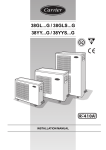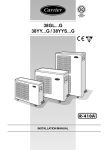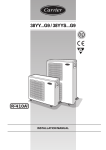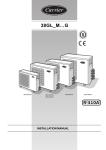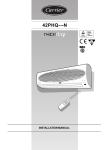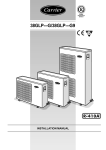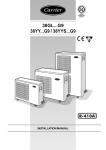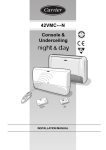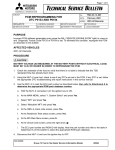Download Carrier 38YY...G Installation manual
Transcript
R QUALIT TE Y SURANC E AS • YD'S REGI S LO 38YY…G IS O 900 1 L R-410A INSTALLATION MANUAL For operation and maintenance instructions of this unit as well as installation instructions of the indoor unit, refer to the relevant manuals. Contents Dimensions and weight ................................................................................................................. Connections ................................................................................................................................... Minimum clearances ...................................................................................................................... Operating limits .............................................................................................................................. Accessories ................................................................................................................................... General information ....................................................................................................................... Warnings: avoid ............................................................................................................................. Refrigerant connections ................................................................................................................ Electrical connections ................................................................................................................... Electrical data ................................................................................................................................ Pump down and check the refrigerant charge ............................................................................... Unit maintenance ........................................................................................................................... Troubleshooting and guide for the owner ....................................................................................... Supplement instructions ................................................................................................................ Page 2 2 3 3 3 4 5 6/8 9/10 10 11 12 12 13 ENGLISH 38YY…G R-410A Heat pump split system outdoor units ATTENTION INSTALLERS AND SERVICE TECHNICIANS! AIR CONDITIONER WITH R-410A–QUICK REFERENCE GUIDE • R-410A refrigerant operates at 50%-70% higher pressures than R-22. Be sure that servicing equipment and replacement components are designed to operate with R-410A. • R-410A refrigerant cylinders are pink. • R-410A refrigerant cylinders have a dip tube which allows liquid to flow out with the cylinder in a vertical position with the valve at the top. • R-410A systems should be charged with liquid refrigerant. Use a commercial type metering device in the manifold hose in order to vaporize the liquid refrigerant before it enters in the unit. • R-410A, as other HFCs, is only compatible with oils selected by the compressor manufacturer. • A vacuum pump is not enough to remove moisture from oil. • Oils absorb moisture rapidly. Do not expose oil to atmosphere. • Never open system to atmosphere while it is under vacuum. • When the system must be opened for service, break vacuum with dry nitrogen and replace filter driers. • Do not vent R-410A into the atmosphere. • Use only Carrier matching indoor units (Table I). Unit size Oil type Quantity cc Drier already installed on liquid line of the unit 018 - 024 POE 1120 YES Table I Cooling only models (A/C) Heat pump models (H/P) Hi-Wall “42PHQ” series H/P Hi-Wall “42HMC” series H/P Console “42VMC” series H/P — 38YY-018G 42PHQ018 42HMC018 42VMC018 — 38YY-024G 42PHQ024 42HMC024 42VMC024 — 38YYS018G 42PHQ018 42HMC018 42VMC018 — 38YYS018G 42PHQ024 42HMC024 42VMC024 Power supply 230V ~ 50Hz GB - 1 38YY…G R-410A Dimensions and weight A A Mod. B B E D E E F C D E A B C D E F Ø 8,5 Ø 8,5 Mod. 38YY-018G Mod. 38YYS018G Mod. 38YY-024G Mod. 38YYS024G 38YY- 018 024 mm 800 800 mm 590 803 mm 300 300 mm 508 508 mm 146 146 mm 330 330 46 52 kg F C 38YY- Connections 2 1 3 3 햲 Outdoor unit 햳 Indoor unit 햴 Height difference 1 2 Table II: Connections Model 018 10 m Max. height difference 30 m Max. pipe length Model 018 - 024 GB - 2 Pipe diameter Gas Liquid (Suction) (Liquid) mm 12.70 6.35 024 Minimum nominal thickness (mm) 1/4” - 6,35 0,80 1/2” - 12,70 0,80 15 m 40 m Pipe diameter Gas Liquid (Suction) (Liquid) inches 1/2” Minimum nominal thickness Pipe diameter inches - mm 1/4” All fittings are flare type. Use only refrigeration grade pipes, (Cu DHP type according to ISO 1337), seamless, degreased, deoxidized and suitable for operating pressures of at least 4200 kPa and with a burst pressure of 20700 kPa. Under no circumstances must sanitary type copper pipe be used. 38YY…G R-410A Minimum clearances ENGLISH D A C B E Model 018 024 A mm 50 100 B mm 250 250 C mm 500 500 D mm 50 50 E mm 470 470 F mm 400 400 Table III: Operating limits (1) Cooling (2) outdoor temperature 43°C Maximum conditions indoor temperature 32°C d.b.; 23°C w.b. outdoor temperature 15°C Minimum conditions Heating (3) Notes: 1. 2. 3. 4. indoor temperature 21°C d.b.; 15°C w.b. outdoor temperature 24°C d.b.; 18°C w.b. Maximum conditions Mains power supply (4) indoor temperature 27°C d.b. Minimum conditions outdoor temperature –15°C d.b.; –17°C w.b. Nominal single-phase voltage Operating voltage limits 230V ~ 50Hz min. 198V – max. 264V Data referred to the outdoor unit only. According to ISO 5151.2/T1. According to ISO 5151.2/High+. 38YYS units are provided with head pressure control suitable up to –15°C ambient temperature. WARNING: During heat pump operation unit will undergo several defrost cycles to eliminate ice that might possibly collect on the outdoor unit in very low ambient temperatures. In these cycles, fan speed will automatically reduce and cannot be varied until defrost cycle is completed. d.b. - dry bulb w.b. - wet bulb Table IV: System charge Size Refrigerant charge (g) Suitable up to Extra charge Extra charge (g) with indoor unit m g/m 42VMC Heat pump 018 1530 8 15 – Heat pump 024 1900 8 30 220 Table V: Accessories Description Part number Wall bracket kit Drain pan electric heater kit (1) Drain pan electric heater kit (1) 38YL-900---001-40 38YL-900---021-40 38YL-900---027-40 38YY-…G 018 024 앬 앬 앬 앬 (1) NOTE : Mandatory for installation in climates where outdoor temperature may be below 0° C. GB - 3 38YY…G R-410A General information R-410A systems operate at higher pressures than standard R-22 systems. Do not use R-22 service equipment or components on R-410A equipment. Read this instruction manual thoroughly before starting the installation. • This unit complies with low-voltage (EEC/73/23) and electromagnetic compatibility (EEC/89/336) directives. • Check that the impedance of the mains power supply is in conformance with the unit power input indicated in the electric data table VI, on page 10 (EN 61000-3-11). • The installation must be carried out by a qualified installer. • Follow all current national safety code requirements. In particular ensure that a properly sized and connected ground wire is in place. • Check that voltage and frequency of the mains power supply are those required; the available power must be adequate to operate any other possible appliances connected to the same line. Also ensure that national safety code requirements have been followed for the mains supply circuit. • The mains supply must be connected to the outdoor unit. • Connect indoor and outdoor units with field-supplied copper pipes by means of flare connections. Use insulated seamless refrigeration grade pipe only, (Cu DHP type according to ISO1337), degreased and deoxidized, suitable for operating pressures of at least 4200 kPa and for burst pressure of at least 20700 kPa. Under no circumstances must sanitary type copper pipe be used. • After installation thoroughly test the system operation and explain all system functions to the owner. • Leave this manual with the owner for consultation during future periodic maintenance. • Use this unit only for factory approved applications: the unit is suitable for outdoor installation. • This installation manual describes the installation procedures of the outdoor unit of a residential split system consisting of two units manufactured by Carrier. Consult factory or a qualified system engineer prior to connecting this unit to any other manufacturer's indoor unit. Coupling units which have different control systems, may cause irreversible damage and void the warranty protection. The manufacturer declines any liability for system malfunction resulting from unapproved coupling. IMPORTANT: During the unit installation make first refrigerant connections and then electrical connections. If unit is uninstalled first disconnect electrical cables, then refrigerant connections. WARNING: Disconnect the mains power supply switch before servicing the system or handling any internal parts of the unit. • The manufacturer declines any liability for damage resulting from modifications or errors in the electrical or refrigerant connections. • Failure to observe the installation instructions or use of the unit under conditions other than those indicated in Table III “Operating limits”, will immediately void the unit warranty. • Failure to observe electric safety codes may cause a fire hazard in case of short circuits. • Inspect equipment for damage due to improper transportation or handling: file an immediate claim with the shipping company. Do not install or use damaged units. • In case of any malfunctioning turn the unit off, disconnect the mains power supply and contact a qualified service engineer. • This equipment contains R-410A refrigerant, a substance that is not depleting the ozone layer. • All of the manufacturing and packaging materials used for your new appliance are compatible with the environment and can be recycled. • Dispose of the packaging material in accordance with local requirements. • This equipment contains refrigerant that must be disposed of in a proper manner. When disposing of the unit after its operational life, GB - 4 remove it carefully. The unit must then be delivered to an appropriate disposal center or to the original equipment dealer. • Carefully recover refrigerant within this unit before final disposal or when servicing. Never vent refrigerant to atmosphere. Use approved recovery equipment for R-410A refrigerant. Do not use R-22 equipment. Choosing the installation site Positions to avoid: • Exposed to direct sun. • Too close to sources of heat radiation, vapour or flammable gas. • Particularly dusty areas. Recommendations: • Choose a position protected from opposing winds. • Choose a position sheltered from direct sun. • Choose an area where air outlet and unit noise will not bother your neighbours. • Choose a position that allows for the clearances required. • Floor structure should be adequately strong to support unit weight and minimize vibration transmission. • Consider a position which will not obstruct passageways or doors. A mm � B mm Unit installation Model 018 - 024 A 508 B 330 � No. 4 Ø 8 mm pins. � Protrusion height from the support surface max. 20 mm. • Fix the unit with locally purchased bolts buried in the block to prevent overturning due to strong gusts of wind. 햲 햳 햴 햲 100 mm min. 햳 20 mm gradient. 햴 Gravel-filled trench. • For heat pump models, unit must be adequately raised above floor surface. 햵 햶 햵 Drain fitting 햶 Vinyl pipe • To drain the condensate water to a drain while operating in heating mode, insert the drain fitting into the hole underneath on the left of the base and use a vinyl pipe with a 16 mm internal diameter. It must not be used at temperatures lower than 0°C. (not supplied for low temperature versions). Snow • If the unit is installed in areas where heavy snowfalls may occur, it is necessary to raise its level at least 200 mm above the usual snow level or alternatively to use the outdoor unit bracket kit. 38YY…G R-410A Warnings: avoid.... ENGLISH Disconnecting the refrigerant connections after installation: this will cause refrigerant leaks. Connecting the condensate drain pipe to the outdoor unit. Excessive height difference between indoor and outdoor unit (see Table II "Connections"). Excessive distance between indoor and outdoor units. (see Table II "Connections"). Predominant head winds. Unnecessary turns and bends in the connecting pipes. Multiple unit installation with units facing each other. Any slack in the electrical connections. Insulating the connecting pipes only partially, which will cause dripping. Dripping into passageways. Flattening or kinking of refrigerant or condensate pipes. Any obstruction of the unit air outlet and intake or any obstacle that is too close (see minimum clearances required). Installation on grassy ground or soft surfaces (in these cases a solid foundation must be included). Soiling of pipe ends. Allowing piping to get wet before connection. GB - 5 38YY…G R-410A Refrigerant connections No moisture. No dust. Charge liquid-no gas. No leak. No mineral oil. Copper tubes during storage. Neat. 1/2” UNF (R-410A) 7/16” UNF (R-22) Use tools designed for R-410A higher pressure. Keep inside clean. Dry nitrogen brazing. Min. – 100 kPa (– 755 mmHg) Vacuum. GB - 6 2-stage vacuum pump. Replace oil regularly. 38YY…G R-410A Refrigerant connections ENGLISH Flaring the ends of the tubing 2 1 The unit can be installed: 햲 on the floor; 햳 on the wall using the bracket kit. Remove protective caps from copper tube ends. Position tube end downward, cut the tube to the requested length and remove the burrs with a reamer. Connect tubing in accordance with the limits shown on Table II (Connections). Finger-tighten the fitting several turns, then tighten it with a wrench by applying the tightening torque indicated in the table. Do not leave system open to atmosphere any longer than minimum required for installation. Oil in the compressor is extremely susceptible to moisture absorption. Always keep ends of tubing sealed during installation. The maximum residual quantity of oil used for tubing is 40 mg/10 m. Where required, the unit must be charged with additional refrigerant. Additional charge must be added using electronic scales and the service port (5/16”) on the suction line. Charge refrigerant only in liquid phase (bottle turned upside down or using the specific connection on bottle; see page 1). Connection to unit 햴 Remove flare nuts from the unit connections and place them on the tube end. Flare the tube with the flaring tool. L L 햴 Adjustable wrench or torque wrench Insufficient tightening torque will cause gas leaks. Overtightening the fittings will damage the tube flaring and cause gas leaks. Pipe diameter 6.35 mm (1/4”) 12.70 mm (1/2”) Flare end must not have any burrs or imperfections. The length of the flared walls must be uniform. Valve Flare nut Wrench mm Nm Tightening torque Nm 18 55 Tightening torque Valve cap Pressure port cap Wrench mm Nm Wrench mm Nm Valve needle Wrench mm Nm Pressure port Wrench mm Nm 1/4” 17 18 23 20 18 16 - 18 Allen (hex.) 5 9 – 0.34 1/2” 26 55 29 40 18 16 - 18 Allen (hex.) 5 13 – 0.34 GB - 7 38YY…G R-410A Refrigerant connections 햶 햷 햸 햺 햹 햹 햻 햴 햳햲 햵 햴 햺 햾 햲 Three-way valve (Gas) 햳 Needle valve 햴 Valve cap 햵 Valve needle 햶 Allen (hex. head) wrench 햷 Two-way valve (Liquid) 햸 Flare nut 햹 Liquid line (small diameter) 햽 햺 Gas line (large diameter) 햻 Indoor unit 햽 Outdoor unit 햾 Vacuum pump Air purging Use only a vacuum pump to purge air from the piping. 헁 NEVER use the system compressor as a vacuum pump. NEVER use the unit refrigerant gas to purge the connecting pipes. 햿 No additional refrigerant has been provided in the unit for this purpose. 헀 Remove the caps from the two and three-way valves. Create a vacuum with a vacuum pump connected to the service connection of the suction shut-off valve, as shown, keeping the shut-off valves completely shut until a 50 Pa (0.5 mbar) vacuum has been reached. Now open the two-way valve for 3 sec., then quickly shut it to check for possible leaks. After the leak check, fully open the two and three-way valves. Replace caps and check for leaks. Finally wrap the valves and pipes with anti-condensate insulation and tighten this with tape, without exerting too much pressure on the insulation. Once all connections have been completed, check for leaks by using a leak detector specific for HFC refrigerants. Repair and cover any possible cracks in the insulation. Fix the pipes to the wall with hooks or conduits. GB - 8 햿 Pipe 헀 Pipe insulation 헁 Fastening tape 38YY…G R-410A Electrical connections ENGLISH Heat pump unit L N R C Y O W2 S Terminal box legend Earth. L N R C Y O W2 S L Live power supply. N Neutral power supply. R Live connection indoor/outdoor unit. C Neutral connection indoor/outdoor unit. Y Compressor interlocking contact. O Reversing valve control. W2 Outdoor fan signal. S 햲 Defrost end signal. 햳 Heat pump system 햲 10 120 쐃 10 100 230V ~ 50Hz R C Y O W2 S 햳 쐋 쐏 햲 Mains supply connecting cable (field wiring). 햳 Connecting cable, indoor-outdoor units (field wiring). L N R C Y O W2 S 쐃 Indoor unit 쐇 Outdoor unit 쐇 쐋 Main switch 쐏 Time-delay fuse or circuit breaker (see table VI “Electrical data”). GB - 9 38YY…G R-410A Electrical connections • Remove electric box cover. • Make electrical connections between units prior to proceeding to mains supply unit connection. • Connect the wires to the terminals according to the wiring diagram and firmly tighten. • Before proceeding with the unit connection to the mains supply locate live L and neutral N, then make connections as shown in the wiring diagram. • Ensure that mains supply connection is made through a switch that disconnects all poles, with contact gap of a least 3 mm. • The mains supply connecting cable must be H07 RN-F type (or higher), synthetic rubber insulation with neoprene coating, according to EN 60335-2-40 and HD277.S1 codes. Note: All field electrical connections are the responsibility of the installer. • Make refrigerant connections before electrical connections. When disassembling, disconnect electrical connections before refrigerant connections. IMPORTANT: Make ground connection prior to any other electrical connections. Refer to the indoor unit installation manual for sizing the connection wires between units. Note: After connections have been completed, replace electric box cover. Table VI: Electrical data Power input Starting current (3) (2) Main power connections (6) Cooling Heating Peak conditions Nominal conditions 198V ~ 50Hz 230V ~ 50Hz ISO 5151.2/T1 ISO 5151.2/T1 indoor 27°C d.b. 19°C w.b. indoor 32°C d.b. 23°C w.b. outdoor 35°C d.b. 24°C w.b. outdoor 43°C d.b. 32°C w.b. Nominal conditions Peak conditions 230V ~ 50Hz 198V ~ 50Hz ISO 5151.2/High+ ISO 5151.2/High+ indoor 20°C d.b. 15°C w.b. indoor 27°C outdoor 7°C d.b. 6°C w.b. outdoor 24°C d.b. 18°C w.b. Time-delay fuse gL type Wire size (4-5) Heat pump A A W A W A W A W A mm 2 38YY- 018G 40 8.8 1980 12.4 2430 8.9 2015 11.8 2300 20 2.5 38YY- 024G 38YYS 018G 38YYS 024G 60 40 60 11.4 8.8 11.4 2465 1980 2465 14.9 12.4 14.9 2890 2430 2890 12.2 8.9 12.2 2675 2015 2675 14.3 11.8 14.3 2775 2300 2775 25 20 25 2.5 2.5 2.5 Notes: 1. 2. 3. 4. 5. 6. GB - 10 Unit is suitable for outdoor installation. Data referred to the outdoor unit only. Starting current duration is usually lower than 1 sec. Wire size shown applies to line length up to 15 m. If the indoor unit is provided with an electric heater, consult indoor unit installation manual for correct sizing of the wires. The mains supply connecting cable must be H07 RN-F type (or higher), synthetic rubber insulation with Neoprene coating, according to EN 60335-2-40 and HD277.S1 codes. 38YY…G R-410A Pump Down and check the refrigerant charge ENGLISH Pump-down Check the refrigerant charge Pump-down is an operation intended to collect all the system refrigerant in the outdoor unit. This operation must be carried out before disconnecting the refrigerant tubing in order to avoid refrigerant loss to the atmosphere, if it becomes necessary to disconnect the refrigerant connections for unit repair, removal or disposal; in this case, after removal, unit must be delivered to an appropriate disposal centre or the original dealer. • This check becomes necessary after any refrigerant leak due to incorrect connection, or after replacement of the compressor. Shut off the liquid valve with the Allen wrench. Turn the system on in cooling with fan operating at high velocity. (Compressor will immediately start, provided 3 minutes have elapsed since the last stop). After 2 minutes of operation, shut the suction valve with the same wrench. Turn the system off and switch mains supply off. • R-410A refrigerant cylinders contain a dip tube which allows liquid refrigerant to flow out with the cylinder in a vertical position with the valve at the top. Charge R-410A units with the cylinder in a vertical position and a commercial-type metering device in the manifold hose in order to vaporize the liquid refrigerant before it enters in the unit. Charge refrigerant into the suction line. • The best method to correctly charge refrigerant is to completely empty the refrigerant circuit using refrigerant recovery equipment. Then charge the exact quantity of refrigerant according to the data shown on the unit nameplate. This can be done with charging equipment of the “Dial a charge” type. Disconnect tubing. After disconnection, protect valves and tubing ends from dust. Compressor damage may occur if run at a negative suction pressure. Refrigerant charge control heat pump unit Cooling cycle Heating cycle 15 15 7 5 Te Ta 7 5 11 11 18 10 2 10 14 2 16 17 4 13 18 1 14 16 4 6 12 8 13 7 Ti 17 6 12 8 7 Legend: 햲 햳 햴 햵 햶 햷 햸 햹 햻 Outdoor coil Compressor Metering device Strainer Vapor valve Liquid valve Service pressure port Additional pressure port Indoor unit coil 햽 햾 햿 헀 헁 헂 헃 헄 Liquid distributor Cooling metering device Heating metering device Additional suction accumulator Reversing valve Defrost end thermostat Crankcase heater Discharge muffler Gas Liquid + Gas Liquid GB - 11 38YY…G R-410A Unit maintenance, troubleshooting and guide for the owner Unit maintenance The following maintenance operations must be carried out by qualified personnel. Cleaning the coil When necessary, proceed as follows for more careful cleaning of the coil: Switch the mains supply OFF. Remove unit top cover by loosening holding screws and lifting the cover. Compressor runs continuously: • Unit selected too small for actual air conditioning needs. • Indoor temperature selection too low (if in cooling) or too high (if in heating, for heat pump models); check temperature selection. • Refrigerant charge low; check and add refrigerant. • Condenser fan (outdoor or indoor, in case of heat pump operation) faulty; replace. • Air or other non condensable gases in the circuit; drain refrigerant (see note 1), evacuate and recharge. • Obstructions at air intake or dirty indoor unit filters; remove obstruction or clean filter. Frequent ice build-up on outdoor coil (during heating with heat pump units): • Outdoor fan stopped; check cause and repair. • Wrong electrical connections between indoor and outdoor units; check electrical connections and repair. • Check defrost end thermostat positioning and connection. Discharge pressure too high: • Outdoor coil dirty or obstructed; clean or remove obstructions. • Condenser fan (outdoor or indoor, in case of heat pump operation) faulty; replace. • Refrigerant charge too high; drain some refrigerant (see note 1). • Air or other non-condensable gases in the circuit; drain refrigerant (see note 1), evacuate and recharge. Discharge pressure too low: • Refrigerant charge too low; add refrigerant. • Outdoor coil dirty or obstructed; clean or remove obstructions. • Indoor unit air filter dirty; clean filter. Carefully clean the coil with a vacuum cleaner from inside to outside. With the same vacuum cleaner, dust the inside of the fan compartment and the fan blades. Avoid any damage to the blades which may cause future vibrations and noise. Replace the unit cover and tighten the screws. After long shutdown periods and at commissioning (for heat pump models only) Energize the system by putting the main switch to ON without starting the unit. (Remote control must be in the OFF position). Do not disconnect the main switch during the unit operating season. Troubleshooting Compressor and fan of the outdoor unit will not start: • Unit not energized; check the mains power connections. • Main switch OFF; check and put to the ON position. • Main switch fuses have blown; replace. • Wait for 3 minutes; compressor cycling protection is on. • Pressure switch open; check and eliminate cause. • Mains voltage too low. • Electrical connections loose or wrong; check and repair. Compressor will not start, but outdoor fan is running: • Electrical connections of compressor loose or wrong; check and repair. • Compressor burnt out, seized or protection device on; check for the cause and replace compressor if necessary. • Run capacitor faulty (single-phase models); replace. Compressor starts, but stops due to its overtemperature protection (other than stops caused by the normal operation of the thermostat): • Wrong refrigerant charge (excessive or low) or air or other non condensable gases in the circuit; drain refrigerant (see note 1), evacuate and recharge. • Mains voltage wrong (too high or too low). • Condenser coil (outdoor or indoor, in case of heat pump operation) obstructed; remove obstructions. • Outdoor fan off; check cause and repair. • Run capacitor faulty; check and replace. • Refrigerant circuit clogged; check and remove obstructions. • Reversing valve faulty on heat pump models; replace. • Expansion device clogged or covered with ice; drain refrigerant (see note 1), evacuate and recharge. GB - 12 Suction pressure too high: • Refrigerant charge too high; drain some refrigerant (see note 1). • Reversing valve faulty or internal leak; replace. Suction pressure too low: • Refrigerant charge too low; add refrigerant. • Evaporator coil (indoor or outdoor, in case of heat pump models),covered with ice; see the following points. • Air circulation on the evaporator unit (indoor or outdoor, in case of heat pump models) not sufficient; check for the cause and repair. • Expansion device or suction line clogged: check and repair. • Outdoor fan does not stop during defrost periods (when heating with heat pump models); check electrical connections. Outdoor fan cycling due to its overtemperature protection: • Fan capacitor faulty; replace. • Electrical connection loose; check connections. • Fan bearing seized; check and repair. Outdoor fan motor running always at low speed: • Wiring not connected to the board; check connections between temperature sensor and board. • Temperature sensor is fault; replace the sensor. • Electronic board broken; replace board. Outdoor fan motor running always at high speed: • Temperature sensor is short circuited; replace temperature sensor. • Electronic board broken; replace board. Note 1: Do not release refrigerant to the atmosphere; use refrigerant recovery equipment. Guide for the owner When installation and tests are completed explain the Operation and Maintenance Manual to the owner, with particular attention to the main operating modes of the air conditioner, such as: • Turning the unit on and off. • Functions of the remote control. • Removal and cleaning of the air filters. Leave the two installation manuals for the indoor and outdoor units with the owner for future use during maintenance operations or for any other needs. 38YYS...G Installation instructions supplement ENGLISH Heat pump 쐃 햹 쐇 Head pressure controller: wiring from temperature sensor to printed circuit board SENSOR SENSOR SENSOR CONTROL N. OUT NEUTRAL OUT 햴 햶 햸 햵 햹 햷 LINE OUT LINE IN 쐃 쐇 햴 햵 Outdoor unit Indoor unit Temperature sensor High pressure cut-out 38YYS…G units are designed to work in North European countries climates. These versions are identified on the 5th digit, “S” of their code number. R-410A versions are identified on the 8th digit “G” of their code number. They are factory equipped with Head Pressure Controller, temperature sensed (HPC), high pressure switch (HIP), loss of refrigerant pressure switch (LRPS) and crankcase heater. Operating range Minimum ambient temperature: Power supply Nominal single-phase voltage: Operating voltage limits –15°C 230V ~ 50Hz min. 198V max. 264V Features HPC and HIP Remote Manual Reset. Low ambient head pressure controller (HPC) temperature sensor type for monosplit. Printed circuit board (PCB), nude with insulation coating, quick connection terminals, Heat Pump select terminal. The Head Pressure Controller allows the operating in cooling mode up to –15°C ambient temperature keeping the condensing temperature always above 41°C - 42°C. The “HPC” automatically feels the possible Heating Mode Working, allowing in this case the outdoor unit fan motor to operate at full speed. HIP NEUTRAL IN 햶 Loss of refrigerant pressure switch 햷 Anti freeze thermostat 햸 Crankcase heater 햹 Pressure ser vice port High pressure switch, brazed between outdoor coil and expansion device, remote manual reset through on-off switch of indoor room thermostat. Set point – open at 4200 kPa (42 bar; 610 psig) pressure – close at 3000 kPa (30.0 bar; 420 psig) pressure LRPS Loss of refrigerant pressure switch: brazed between outdoor coil and expansion device when with unit not working, the pressure “high side” drops below 345kPa (3.45 bar; 50 psig) for refrigerant losses, the compressor cannot restart. Set point – open at 345 kPa (3.45 bar; 50 psig) pressure – close at 650 kPa (6.5 bar; 95 psig) pressure HP SELECT Head pressure controller and HIP remote manual reset Configuration The Head Pressure Control “HPC” is made of two parts: • Printed circuit board, with electronic components and quick connector terminals. • Temperature sensor, complete with 500 mm wiring. For the user convenience “HIP” has been selected at automatic reset. If “HIP” trips, cycle the power supply OFF and ON to reset the system, because the electrical box is equipped with relais that prevent the unit from starting, till the indoor control is switched OFF. When head pressure drops below 3000 kPa (30 bar; 420 psig) it is possible to restart the unit switching the indoor control ON. Operations mode Full voltage: When the liquid line temperature is over the setpoint value plus half proportional band (factory set by supplier), the output voltage to the motor is 97% or more of supply voltage. Low voltage: When the liquid line temperature is below set point minus half proportional band, the output voltage to the motor is fixed to 125V. Hard start: At each compressor starting the full voltage output to the fan motor is provided for 3 seconds. Proportional band: The controller directly senses the changes in liquid line temperature and varies the output voltage which causes the fan motor speed increase or decrease. Temperature setting Proportional band Minimum speed output voltage: Setting: Hard start time set point +11 / –11°C 125 V the head pressure controller is supplied factory set at 42°C 3 seconds. Troubleshooting See paragraph “Troubleshooting”. Note: In case of first start after a pause of several hours at – 15°C, with low voltage supply (198V) high pressure switch HIP may trip off the unit. In this case, the remote reset by indoor control (infrared) can be done for unit restarting. GB - 13 L010125H21 - 1201 Via R. Sanzio, 9 - 20058 Villasanta (MI) Italy - Tel. 039/3636.1 The manufacturer reserves the right to change any product specifications without notice. Order No. 13855-74M10, December 2001. Supersedes Order No. (new). Printed in Italy
















